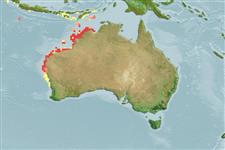ກຸ່ມປາກະດູກອ່ອນ (ເຊັ່ນ: ປາສະຫລາມ, ປາຜາໄລ) (sharks and rays) >
Orectolobiformes (Carpet sharks) >
Orectolobidae (Carpet or nurse sharks)
Etymology: Orectolobus: orektos (Gr.), stretched out; lobus (L.), from lobos (Gr.), rounded projection or protuberance, referring to long nasal barbels of Squalus barbatus (=O. maculatus) (See ETYFish); reticulatus: Latin for net-like or netted, referring to characteristic network pattern on dorsal surface (See ETYFish).
More on authors: Last, Pogonoski & White.
Environment: milieu / climate zone / depth range / distribution range
ນິເວດວິທະຍາ
ສັດທະເລ ກ່ຽວກັບ (ຢູ່)ເທິງຊັ້ນພື້ນດິນໃນທະເລເປີດ; ລະດັບຄວາມເລິກ 0 - 20 m (Ref. 106604). Tropical
Indian and Western oceans of Australia.
ຂະໜາດ / ນ້ຳໜັກ / Age
Maturity: Lm ? range ? - ? cm
Max length : 52.3 cm TL (female)
Short description
ຕົວທີ່ໃຊ້ໃນການຈຳແນກຊະນິດ | ສະລີລະວິທະຍາ | ການວັດແທກຮູບຮ່າງລັກສະນະພາຍນອກຂອງດິນ,ສັດ,ປາ…
This small species (to at least 52.3 cm TL) has the following combination of characters: strong colour pattern with dark saddles, spots and fine reticulations; simple nasal barbel, thallate, without other lobes; poorly developed postspiracular lobes, the posterior postspiracular lobe (PS2) is simple, narrow or weakly thallate, and smaller than anterior postspiracular lobe (PS1); distance across preorbital group 1.3-1.6 times the interspace between preorbital group and anterior postspiracular lobe (PO/PO-PS1), 4.2-5.4 times base length of anterior postspiracular lobe (PO/PS1); base of the anterior postspiracular lobe 3.3-3.9 in its distance from postorbital group (PO-PS1/PS1), 1.5-2.1 in its distance from posterior postspiracular lobe (PS1-PS2/PS1); tubercle above eye prominent; wart-like tubercles absent on back; interorbital denticles are widely spaced, the anterior margins strongly crenulate; tall, upright dorsal fins; origin of first dorsal-fin over mid pelvic-fin base; interdorsal space 0.3-0.5 times the anal-fin base length; anal-fin inner margin 0.4-0.6 times its anal-fin posterior margin; about 21 tooth rows in upper jaw, no medial row at symphysis of upper jaw; 46-49monospondylous centra; 141-147 total vertebral centra (Ref. 76939).
No male adults are known, but a male adolescent, 50.3 cm TL (Ref. 76939).
Life cycle and mating behavior
ການຈະເລີນເຕັມໄວ | ການສືບພັນ | ການວາງໄຂ່ | ໄຂ່ | ຄວາມດົກຂອງໄຂ່ປາ | ຕົວອ່ອນ
Last, P.R., J.J. Pogonoski and W.T. White, 2008. Orectolobus reticulatus sp. nov., a new wobbegong shark (Orectolobiformes: Orectolobidae) from the continental shelf of Northeastern Australia. In Last, P.R., White, W.T. & Pogonoski, J.J. (eds.): Descriptions of New Australian Chondrichthyans. CSIRO Marine and Atmospheric Research Paper no. 22. (Ref. 76939)
IUCN Red List Status (Ref. 130435: Version 2024-1)
Threat to humans
Harmless
Human uses
ເຄື່ອງມື
Special reports
Download XML
ແຫຼ່ງອີນເຕີເນັດ
Estimates based on models
Phylogenetic diversity index (Ref.
82804): PD
50 = 0.5012 [Uniqueness, from 0.5 = low to 2.0 = high].
Bayesian length-weight: a=0.00389 (0.00180 - 0.00842), b=3.12 (2.94 - 3.30), in cm total length, based on all LWR estimates for this body shape (Ref.
93245).
ຊັ້ນເຂດຮ້ອນ (Ref.
69278): 3.7 ±0.6 se; based on size and trophs of closest relatives
ຄວາມຢືດຢຸ່ນ (Ref.
120179): ຕຳ່, ປະຊາກອນຕຳ່ສຸດທີ່ໃຊ້ເວລາສອງເທົ່າ 4.5 - 14 ປີ (Preliminary low fecundity).
Fishing Vulnerability (Ref.
59153): Moderate vulnerability (41 of 100).
